1.5 Experimental Research
The nation of Chile went to heroic lengths to ensure that Los 33 made it out of the mountain alive. Most search-

A photo taken on October 7, 2010, shows two of the three drills used to bore rescue shafts for the miners. The rescue of Los 33 was truly an international collaboration, as workers and equipment from countries all over the world were deployed to the Atacama Desert.
But the Chilean government was not in it alone. Governments, businesses, and individuals from all over the world flooded the Atacama Desert offering whatever help they could. Even a group from the National Aeronautics and Space Administration (NASA) showed up to lend a hand: two doctors, one engineer, and a psychologist named Albert Holland who had trained astronauts to cope with the stressful living conditions of outer space. The NASA crew was impressed with the efforts of the Chileans, but they also offered a few bits of advice, including a recommendation to increase the men’s daily intake of vitamin D (Prengaman, 2010, September 3; Spotts, 2010, September 7).
Why would the miners need more vitamin D? Most people get a substantial amount of vitamin D through sun exposure. When the sun’s UV rays strike the skin, its cells begin synthesizing vitamin D—
Imagine you are a psychologist who has been following the Chilean miner saga. You’ve read the news reports about NASA recommending more vitamin D, which makes you wonder if giving vitamin D supplements will, in fact, improve the men’s cognitive abilities. Here’s the hypothesis you come up with: If one group of miners is given vitamin D supplements and the other group of miners a sugar pill, those receiving the vitamin D supplement will show improvements in cognitive functioning.
Eager to begin your study, you ask the Chilean government for permission to study the cognitive effects of vitamin D supplementation on Los 33. Sadly, your request is promptly denied. Not to worry. You have another option that may be even better: taking your study to a laboratory setting. Performing research in a controlled laboratory environment has huge benefits. You have greater control over who participates in the study, freedom to manipulate the variables, and the ability to draw comparisons between groups that differ only with respect to your target variables. In other words, you have the opportunity to use the experimental method.
Experimental Method
LO 9 Explain how the experimental method relates to cause and effect.
experimental method A type of research that manipulates a variable of interest (independent variable) to uncover cause-
At last, we arrive at the type of research method we have been alluding to all along, a design that reveals cause and effect. Unlike the descriptive studies discussed earlier, the experimental method can tell us about cause and effect, because it aims to ensure that every variable except those being manipulated by the researcher is held constant, or controlled (Infographic 1.5). To identify a particular cause of an outcome, we assign research participants to two or more groups, and with the exception of some sort of manipulation or treatment done by the experimenter, these groups are equivalent. If following the manipulation or treatment the groups differ on a measure of interest, we can say with confidence that the experimental manipulation caused that change. This allows researchers to observe the variable of interest without interference from other variables.
If you are having trouble understanding what it means to control variables, consider this analogy: You are outside a football stadium, desperately trying to follow a friend lost in a swarm of people. Everyone is moving in different directions, making it exceedingly difficult to pinpoint your friend’s location and direction of movement. But what if everyone in the crowd except your friend froze for a moment in time? Would it be easier to observe him now that he is the only one moving? This is similar to what researchers try to do with variables—
Returning to the sun-
random assignment The process of appointing participants in a research study to the experimental or control groups, ensuring that every person has an equal chance of being assigned to either.
RANDOM ASSIGNMENT Assigning participants to groups is a crucial step of the experimental method. Fail to divide participants in the correct way and your whole study is compromised. For this reason, researchers use random assignment to ensure that participants have an equal chance of being assigned to any of the groups. Randomly choosing which treatment the participants receive reduces the possibility of some participant characteristics influencing the findings. You may have noticed some similarities between random assignment and the “random sample” introduced earlier in the chapter. But here’s the difference: Random sampling is used at the onset of a study to gather participants from a larger population. Random assignment comes into play later, when you are assigning participants to different groups. You can flip a coin, roll dice, or use a computer to generate numbers, but the goal of random assignment is always the same: to ensure that the groups are roughly equal on all characteristics. If the groups are lopsided with respect to some variable, the results may be affected. Getting back to your study on vitamin D and cognition, imagine that you assigned all the highly educated participants to one group and the less educated participants to the other. Might educational experience influence the results of a cognitive test? Perhaps. Random assignment helps reduce some of the interference resulting from these types of characteristics.
INFOGRAPHIC 1.5
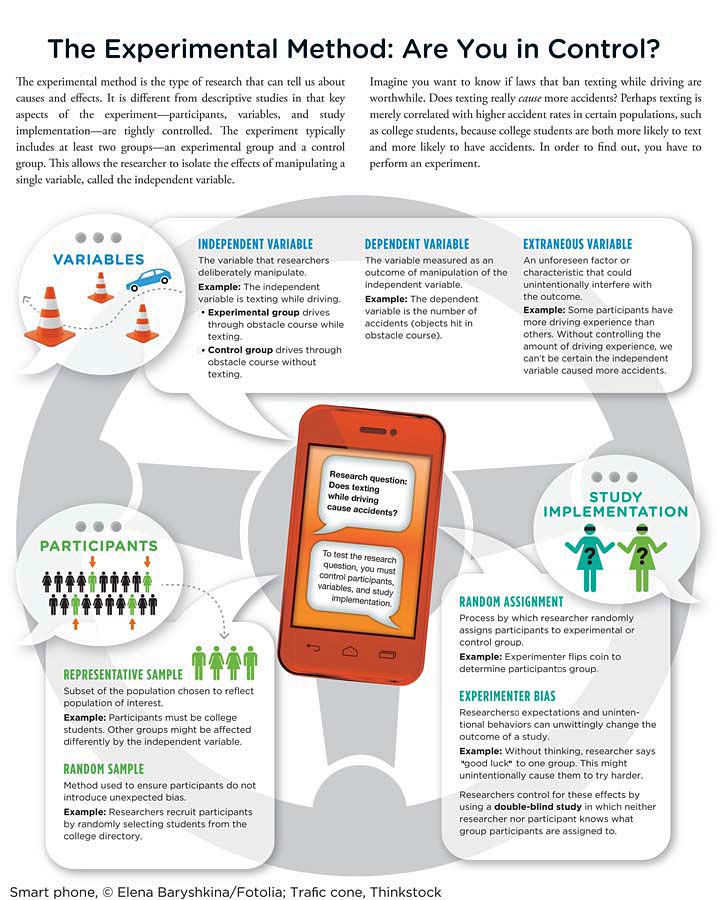
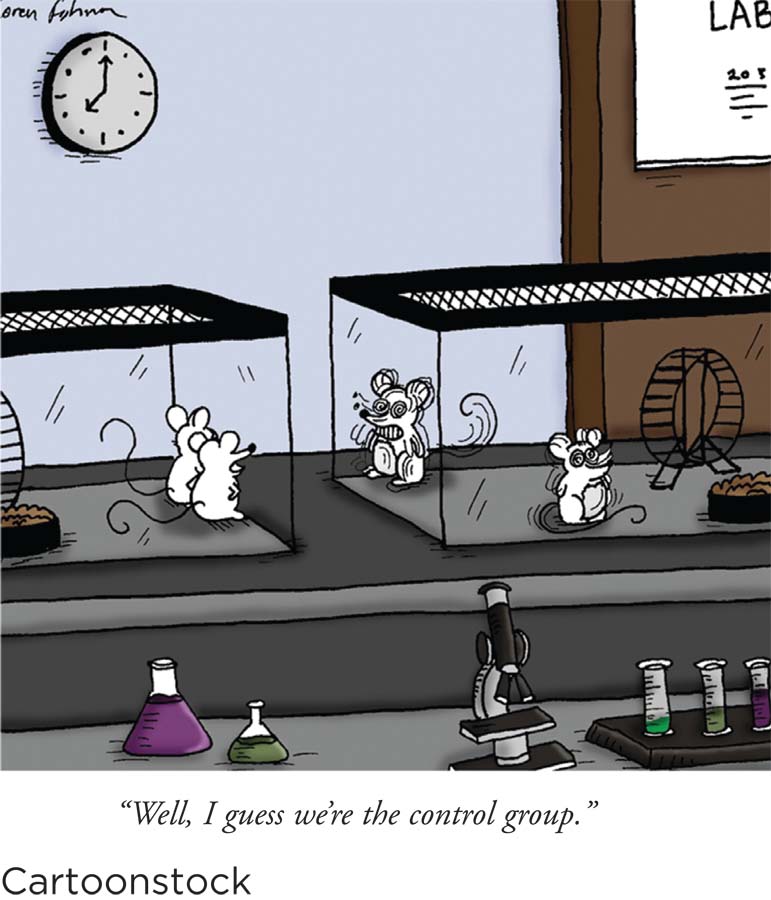
control group The participants in an experiment who are not exposed to the treatment variable; this is the comparison group.
Synonyms
experimental group treatment group
independent variable explanatory variable
dependent variable response variable
EXPERIMENTAL AND CONTROL GROUPS Let’s assume you did use random assignment to divvy your participants into two groups. One will receive the treatment (a daily dose of vitamin D), and the other will receive no treatment at all (they will, however, be handed a sugar pill that looks identical to the vitamin D supplement). Those members of the group who get the treatment (the real vitamin D supplements) comprise the experimental group, and those participants who get the sugar pill are members of the control group, and they do not receive the treatment. (We explain the need for the fake treatment in a moment.)
independent variable (IV) In the experimental method, the variable manipulated by the researcher to determine its effect on the dependent variable.
dependent variable (DV) In the experimental method, the characteristic or response that is measured to determine the effect of the researcher’s manipulation.
INDEPENDENT AND DEPENDENT VARIABLES Let’s restate a point we already made earlier in the section, this time using our new vocabulary terms: The only difference between the experimental and control groups should be the variable the researchers are manipulating—
extraneous variable A variable in the environment or of the participants that could unintentionally influence the outcome of a study.
EXTRANEOUS VARIABLES Another issue that must be considered by researchers as they plan their experiment is making sure that extraneous variables are not allowed to interfere with their measures. Extraneous variables are characteristics of the environment or participants that potentially interfere with the outcome of the research. While conducting your study of vitamin D supplements, you discover that three of the participants are reacting to the artificial light in the lab, making it very difficult for them to sleep. And this sleeplessness can definitely influence performance on cognitive tasks. Unfortunately, you failed to consider this very important variable in your research design, making it an extraneous variable. Researchers have to carefully contemplate the different kinds of variables that might influence the dependent variable.
confounding variable A type of extraneous variable that changes in sync with the independent variable, making it difficult to discern which one is causing changes in the dependent variable.
There is a specific type of extraneous variable that can confound the results of an experiment. Confounding variables are a type of extraneous variable that changes in sync with the independent variable, making it very difficult to discern which variable—
The good news is that there are numerous ways of eliminating the influence of an extraneous variable. This is called controlling a variable. As we mentioned earlier, random assignment to the treatment and control groups can help to lessen the impact of such variables. In this example, that means ensuring both groups have approximately the same number of participants who are having trouble sleeping in the lab. Or, if you wanted to control how sleep impacts the outcome of your study, you could just remove the poor sleepers from your sample and not include their information in your statistical analyses.
If you succeed in holding all variables constant except the independent variable, then you can make a statement about cause and effect. Let’s say your study does uncover cognitive differences between the experimental and control groups. It is relatively safe to attribute that disparity to the independent variable. In other words, you can presume that the vitamin D caused the superior performance of the experimental group.
double-
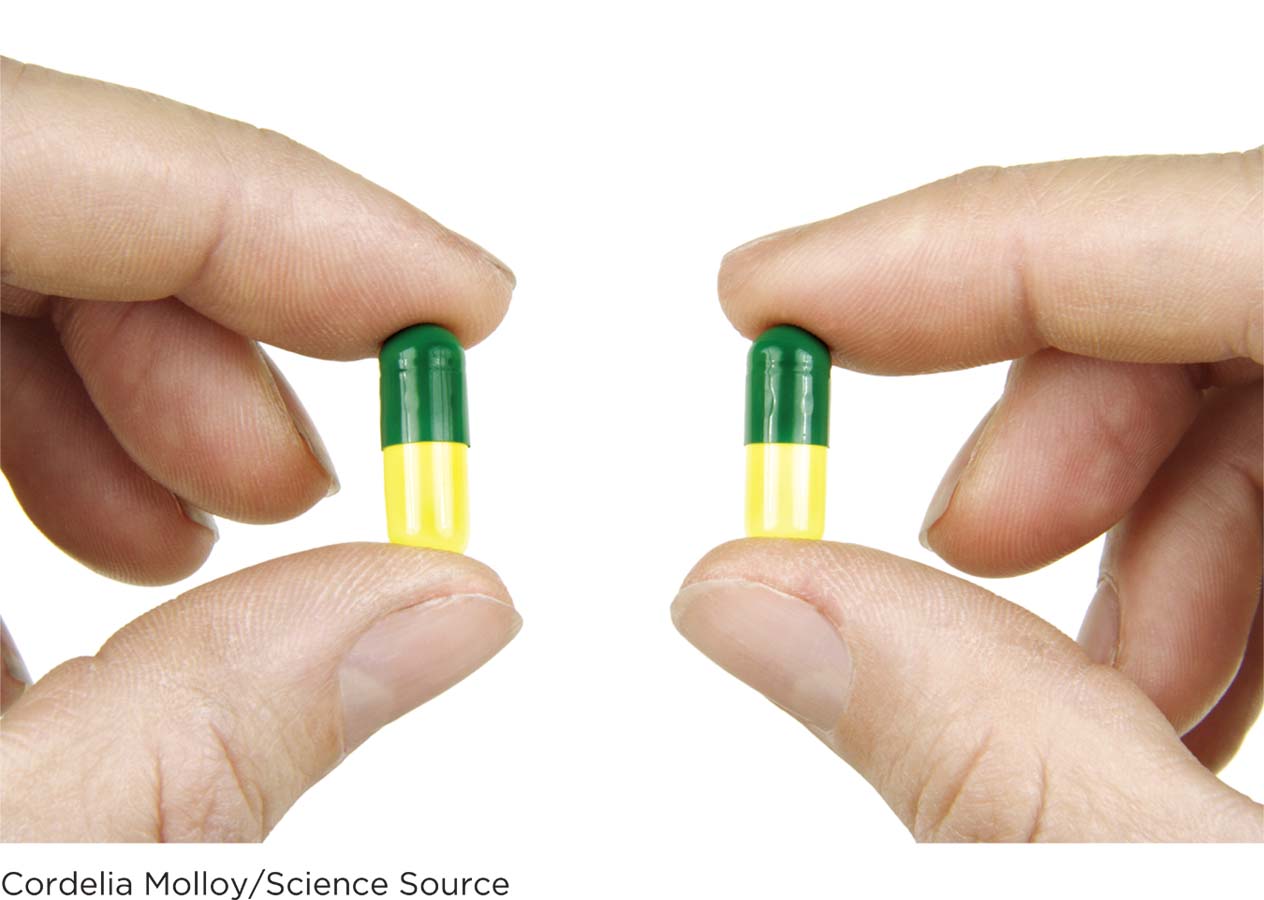
One of these pills contains an active ingredient; the other is a placebo. In placebo-
DOUBLE-
placebo (pl?-ısē-ıbō) An inert substance given to members of the control group; the fake treatment that has no benefit, but is administered as if it does.
THINKING IS BELIEVING There are some very compelling reasons for making a study double-
Synonyms
experimenter bias experimenter effect, researcher expectancy effect
experimenter bias Researchers’ expectations that influence the outcome of a study.
EXPERIMENTER BIAS We’ve discussed the rationale for keeping participants in the dark, but why is it necessary to keep the researchers clueless as well? Researchers’ expectations can influence the outcome of a study, a phenomenon known as experimenter bias. A researcher may unwittingly color a study’s outcome through subtle verbal and/or nonverbal communication with the participants, conveying hopes or beliefs about the experiment’s results. A statement by the researcher like “I really have high hopes for this medicine” might influence participants’ reactions to the treatment. The researcher’s value system may also impact the results in barely noticeable but very important ways. Beliefs and attitudes can shape the way a researcher frames questions, tests hypotheses, or interprets findings (Rosenthal, 2002b).
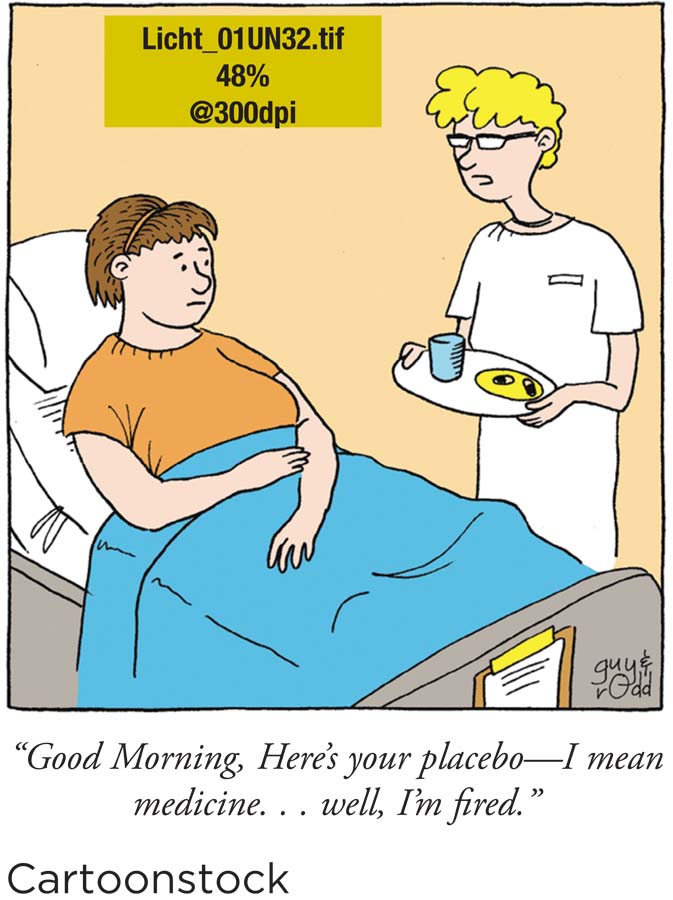
Congratulations! You have now learned the nuts and bolts of the experimental method, one of psychology’s greatest myth-
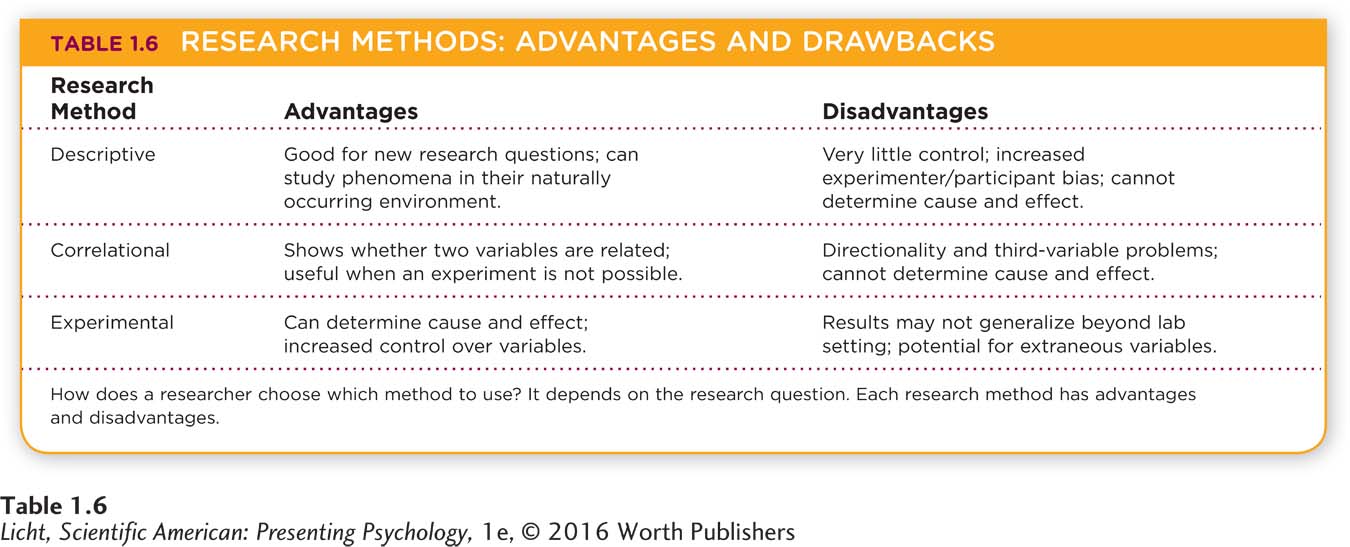
Now it’s time to test our understanding of the experimental method with the help of a sprightly yellow square named SpongeBob.
didn’t SEE that coming
SpongeBob on the Brain
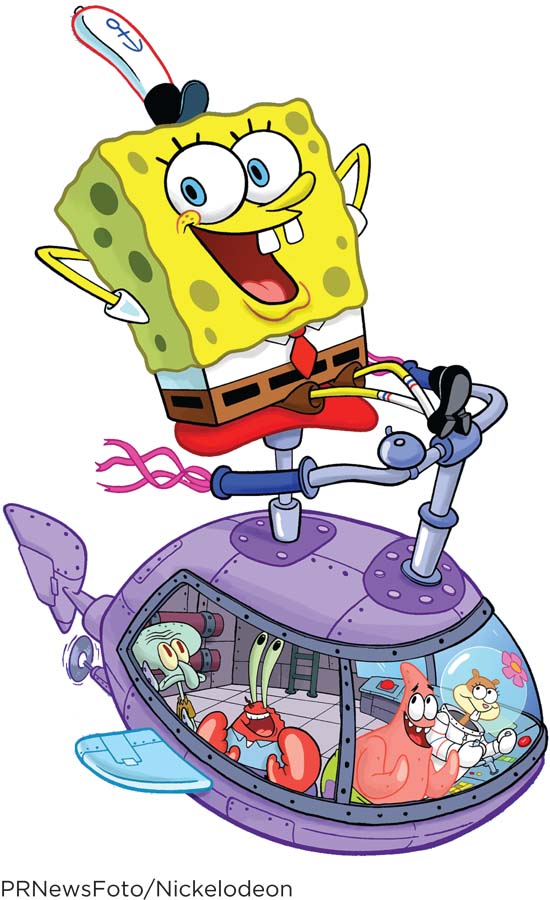
No one expects cartoons to make kids smarter, but can they hurt them? One study suggests that preschool children watching just 9 minutes of the high-
 A little television won’t hurt a child, will it? Kids’ programs are interspersed with lessons on colors, words, and numbers, and only run for periods of 20 to 30 minutes. It seems reasonable to assume that little snippets of TV can’t possibly have any measurable effect.
A little television won’t hurt a child, will it? Kids’ programs are interspersed with lessons on colors, words, and numbers, and only run for periods of 20 to 30 minutes. It seems reasonable to assume that little snippets of TV can’t possibly have any measurable effect.
When it comes to the rapidly developing juvenile brain, however, it’s probably not safe to assume anything. Consider the following controlled experiment examining the cognitive changes observed in preschool children after just 9 minutes of exposure to a talking yellow sponge zipping across a television screen.
TURNING YOUNG BRAINS TO “SPONGE”?
The research participants were 60 four-
How do we know that this was not the result of a different variable, such as some children’s preexisting attentional issues or television-
What aspect of the cartoon caused these effects is not yet known, but the researchers suspect that it has something to do with the show’s “fantastical events and fast pacing” (Lillard & Peterson, 2011, p. 648). Further studies are in the works, so stay tuned.
Research Ethics
LO 10 Demonstrate an understanding of research ethics.
Throughout this chapter, we have used the Chilean mining disaster as a subject for many hypothetical research endeavors, including studies on depression, aggression, and cognition. What we haven’t yet addressed is the enormous ethical responsibility psychologists take on when they decide to conduct these types of studies. Psychologists do not examine dinosaur fossils or atomic particles. They study humans and other living creatures who experience pain, fear, and other complex feelings, and it is their professional duty to treat them with dignity and respect.
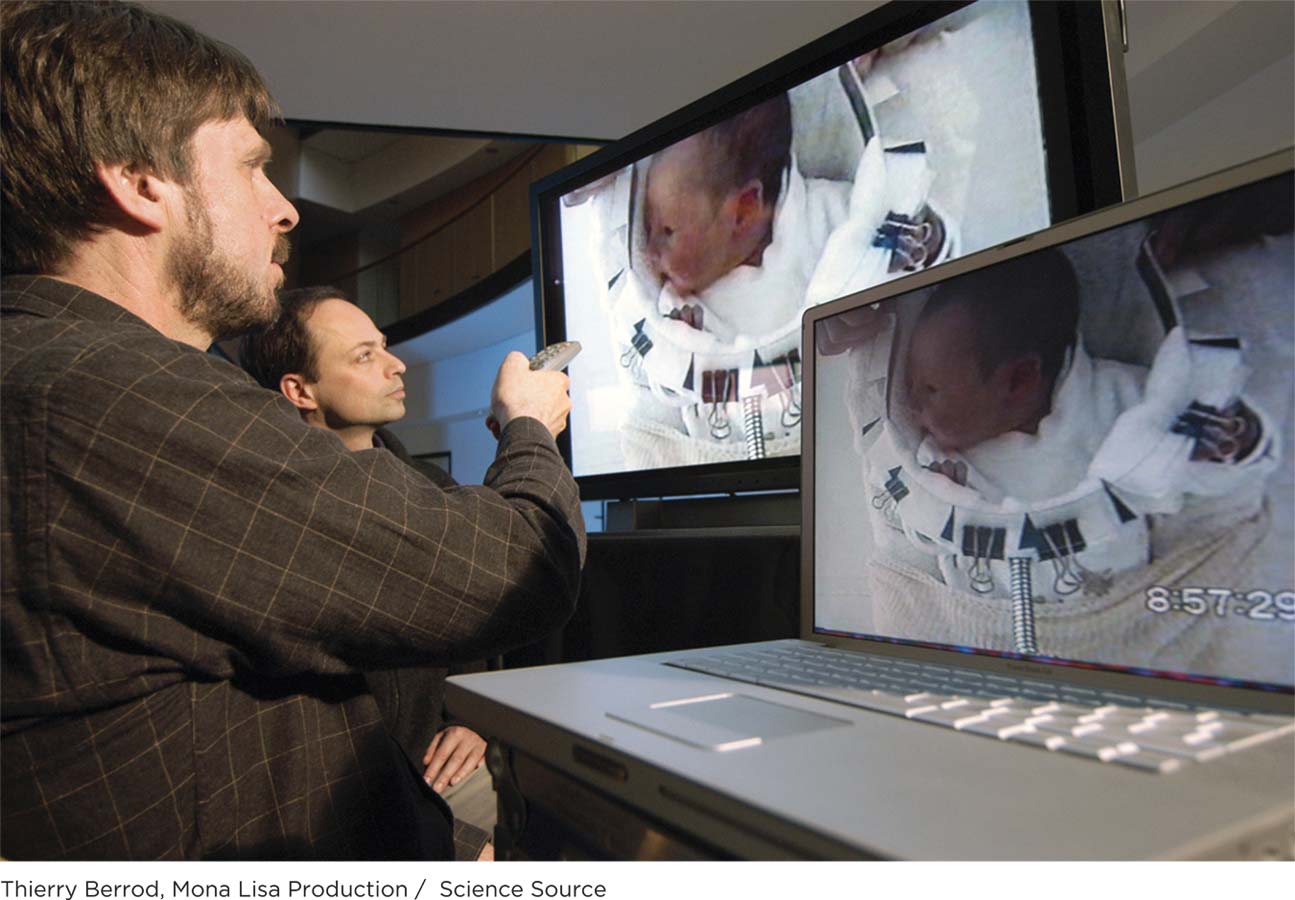
Researchers study a newborn baby responding to smells such as curry and garlic. Certain flavors are familiar to babies because they were exposed to them in utero (through their mothers’ diets). Conducting research on infants and other minors involves additional ethical considerations, and informed consent must be obtained from parents or legal guardians.
Like most other professionals, psychologists have established specific guidelines to help ensure ethical behavior in their field. Professional organizations such as the American Psychological Association (APA), the Association for Psychological Science (APS), and the British Psychological Society (BPS) provide written guidelines their members agree to follow. These guidelines ensure the ethical treatment of research participants (human and animal). They encourage psychologists to do no harm; safeguard the welfare of humans and animals in their research; know their responsibilities to society and community; maintain accuracy in research, teaching, and practice; and respect human dignity, to name a few examples (APA, 2010a).
CONFIDENTIALITY Confidentiality is a primary issue in psychology. Researchers must take steps to protect research data from misuse or theft. Psychologists who offer therapy services are obligated to keep client and therapy session information confidential; in fact, they are required to keep this information safeguarded in their offices. Confidentiality enables clients to speak freely about deeply personal issues. It ensures that research participants feel confident when they share sensitive information (sexual or controversial matters, for example), because they may rest assured researchers will protect it.
DECEPTION Other important ethical topics are informed consent and debriefing, both of which we discussed earlier. Informed consent is the process by which research participants acknowledge their understanding of their role in the study and sign off on it. Debriefing refers to the process in which researchers disclose important information to their participants after wrapping up a study. This includes informing participants about any deception. Throughout this textbook, you will read about experiments in which the participants did not know ahead of time what was being studied. In addition, they were often purposely lied to as a part of the manipulation, or to conceal what was being studied until the debriefing phase. It is important to note that no one is ever forced to become a participant in a research study. Participation is completely voluntary, and participants can drop out at any time.
Apply This
Don't Believe Everything You Read
As you venture deeper into the study of psychology, you may find yourself becoming increasingly skeptical of media reports on psychological research. We encourage a healthy dose of skepticism. Although many news stories on scientific findings are accurate and balanced, others are flawed and overhyped. Look at these headlines about a 2012 study on the psychological impact of pacifier, or “binkie,” use:
SCIENCE, SPIN, OR SOUND BITES?
“Pacifier Use Can Lead to Emotional Problems in Boys, Study Finds”
(Fox News, 2012, September 19).
“UW Study Says Boys’ Pacifier Use Limits Social Development”
(Seely, 2012, September 19).
It sounds as if pacifiers are causing emotional problems in males. We must have a cause-
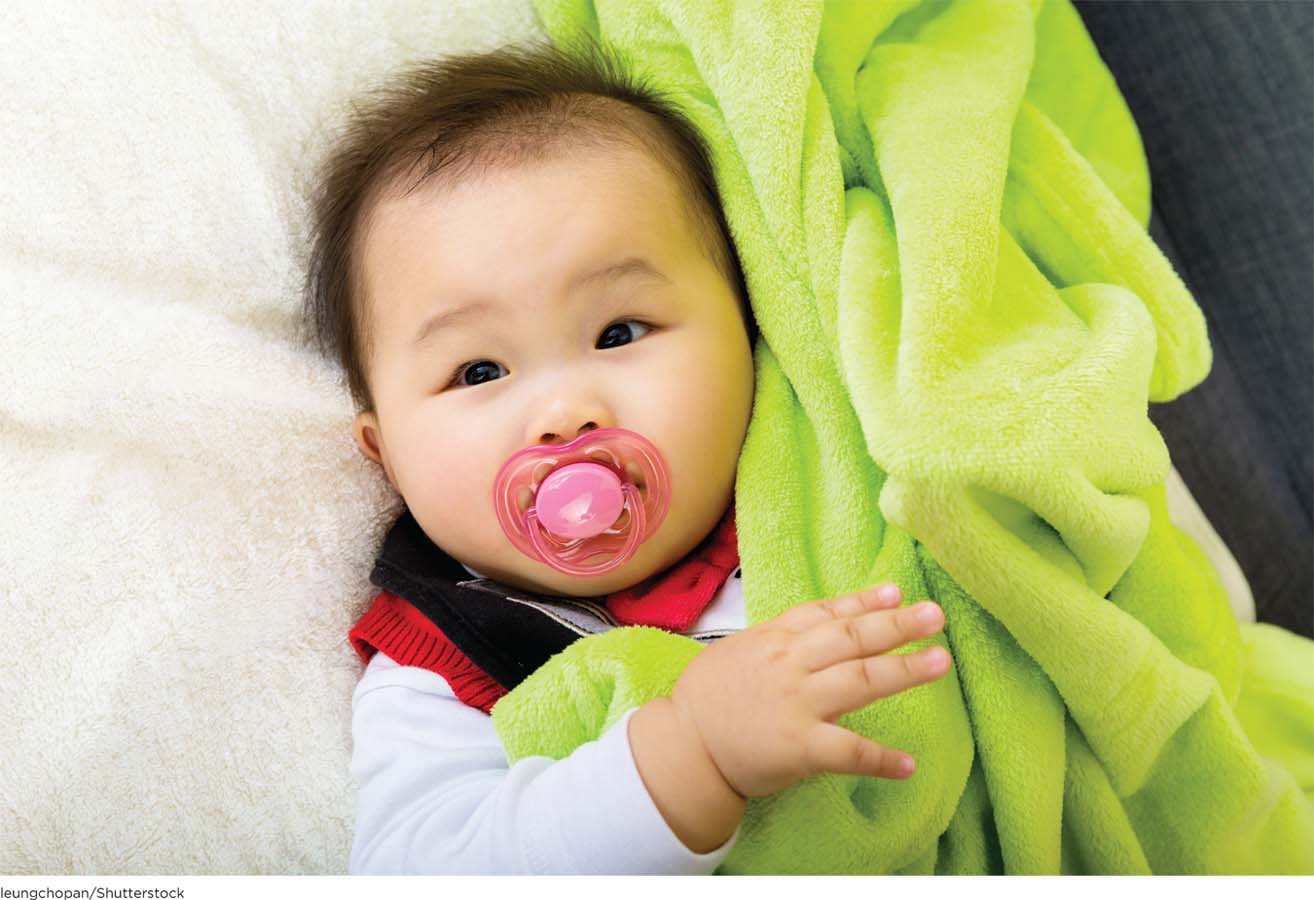
In 2012 researchers published a study showing a correlation between pacifier use in boys and lower levels of emotional intelligence later in life. The findings of this study could easily be interpreted as “pacifier use stunts emotional development,” but this is a reckless conclusion. Think of all the other variables that might affect emotional development: parenting style, exposure to television, nutrition, interactions with siblings. Need we go on?
Provocative as these findings may be, they do not allow us to conclude that pacifiers cause emotional impairments. Isn’t it possible that the reverse is true? Infants with emotional problems are more likely to be given pacifiers (thus the emotional problems are leading to the pacifier use)? The authors explicitly highlight this problem: “The studies do not allow us to draw causal conclusions, as the children were not randomly assigned to pacifier use” (Niedenthal et al., 2012, p. 392). And while the researchers did control for some variables such as the mother’s education and the child’s anxiety level, it is impossible to control for every third variable that might influence emotional health. Can you think of any other factors that could impact the results?
The take-
show what you know
Question 1
1. The experimental method can provide findings on the ____________ among variables.
experimenter bias
confounding
random assignment
cause-
and- effect relationship
d. cause-
Question 2
2. A researcher studying the impact of vitamin D on cognitive functioning gave supplements to the experimental group and a placebo to the control group. After 2 months, she tested the participants’ cognitive functioning, which is a measure of the ____________ variable.
dependent
independent
extraneous
confounding
a. dependent
Question 3
3. Describe what a double-
In a double-
Question 4
4. Following a study involving a double-
informed consent.
debriefing.
deception.
naturalistic observation.
b. debriefing.
 THE RESCUE Tuesday, October 12, 2010: The miners had been dreaming of this day for the last 10 weeks. Rescuers had finally blasted an escape tunnel down to the workshop area, a small cavern located above the safety shelter (Franklin, 2011). They would soon be lowering an elevator-
THE RESCUE Tuesday, October 12, 2010: The miners had been dreaming of this day for the last 10 weeks. Rescuers had finally blasted an escape tunnel down to the workshop area, a small cavern located above the safety shelter (Franklin, 2011). They would soon be lowering an elevator-
The first to ascend would be those believed to be most mentally stable. If something went wrong during the initial ascent, the rescuers wanted someone who could keep his cool onboard (Kraul, 2010, October 11). Florencio Ávalos, the soft-
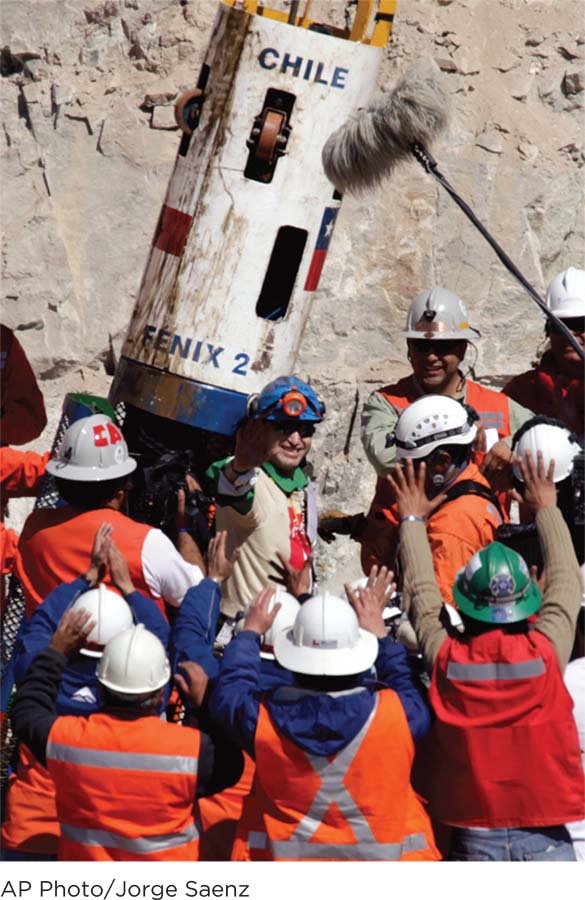
Carlos Barrios emerges from the Phoenix rescue capsule. He was the 13th miner to be hoisted to safety.
The rescue effort spanned 2 days. When all was said and done, all 33 men had been brought to safety. Now everyone wondered how the miners would cope with their new celebrity status. These 33 men had gone from being ordinary working people to the most sought after interview subjects in the world. Reporters, publishing companies, and Hollywood all wanted a piece of Los 33. The group met with movie stars, attended galas, and led parades through Disneyland. One of the miners, Edison Peña, ran the New York City Marathon just weeks after emerging from the mine. He also appeared on The Late Show with David Letterman doing an Elvis impression (Pearson & Siemaszko, 2010, November 6).
But the same Peña who was seen gyrating on the The Late Show was later hospitalized for depression and anxiety. Other miners have also suffered from psychological troubles, including nightmares and difficulty readjusting to family life. Some are taking medications, and nearly a third have suffered from posttraumatic stress disorder (Chapter 11) (Barrionuevo, 2011, October 12; CBS News, 2011, February 10; Tobar, 2014, July 7). Despite these stark aftereffects, the rescue of these 33 men gives us many reasons to be hopeful. Just think about the teamwork, selflessness, and love the miners showed for each other. Remember the rescue workers who toiled around the clock to save the men from their underground nightmare; the wives, mothers, fathers, siblings, cousins, and friends who dropped everything and moved to the Atacama Desert to await the return of their loved ones; and the strangers all over the world who sat around their televisions, crying as they watched the miners emerge from the darkness. It is tragic that many of the miners have suffered psychological wounds, but as you will learn in this book, humans have an amazing way of overcoming adversity. Do not underestimate the positive potential of humanity. 
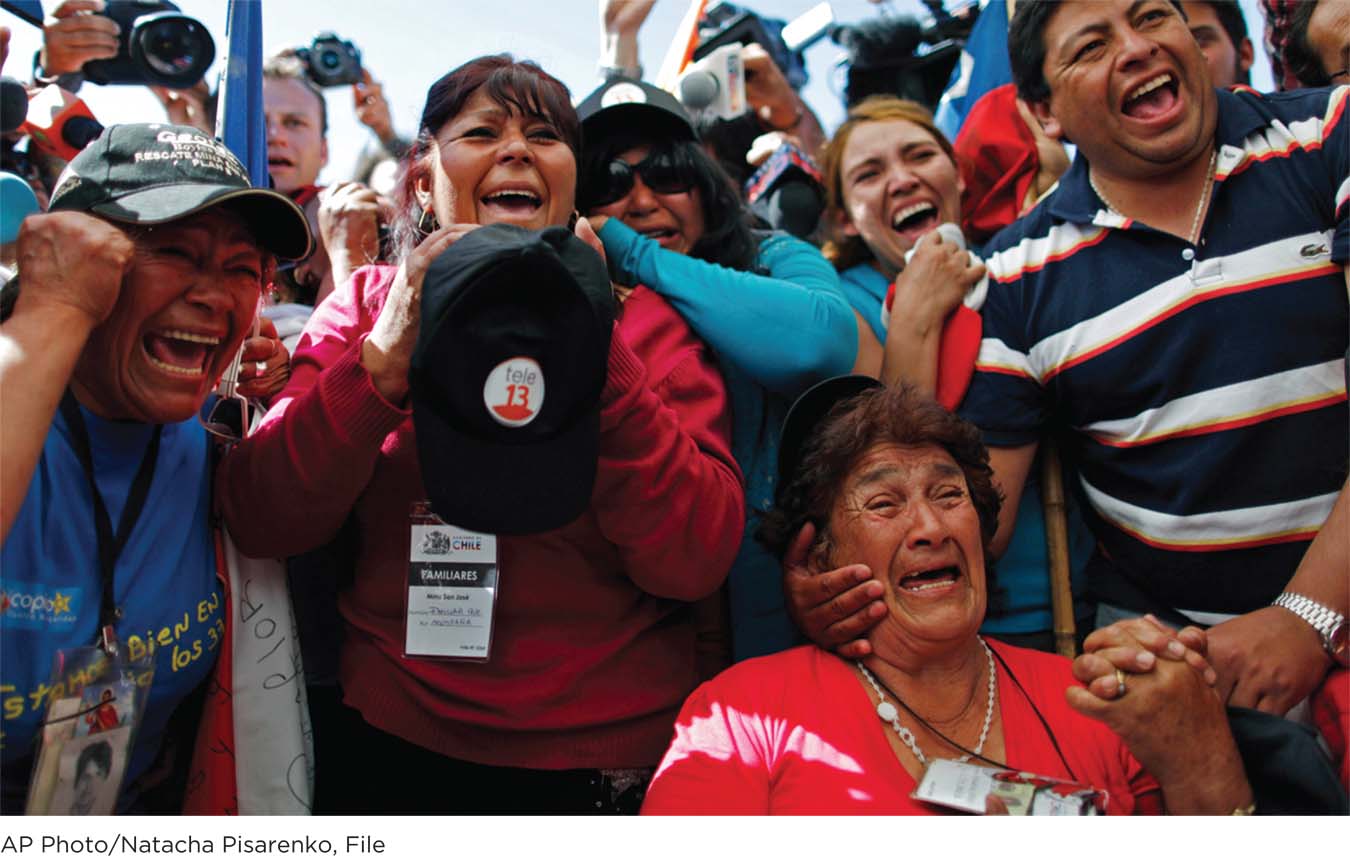
Darío Segovia’s family members erupted in celebration as they witnessed him emerge from the mine on October 13, 2010. They had waited 10 weeks for him to come home.